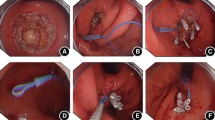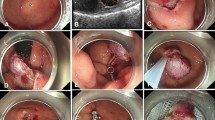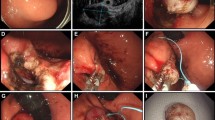Abstract
Background
This study was designed to evaluate the feasibility and efficacy of metallic clips assisted with foreign body forceps closing the gastric wall defect after endoscopic full-thickness resection (EFR) for gastric submucosal tumors (SMTs).
Methods
Eighteen patients with gastric SMTs originated from the muscularis propria were treated by EFR between September 2012 and June 2014. Twelve patients underwent endoscopic closure of the gastric wall defects after EFR with endoloop and metallic clips (endoloop string suture method, ESSM), and six patients with clips and foreign body forceps (clips assisted with foreign body forceps clip method, CFCM).
Results
No significant differences existed between the two groups in terms of demographics, clinical characteristics, and the size of the gastric wall defects. The average time spent in closing the gastric wall defects (14.83 ± 1.94 min for the CFCM group and 22.42 ± 5.73 min for the ESSM group) and hospitalization fees of the CFCM group were significantly lower than those of the ESSM group. The average hospitalization time of the two groups had no statistical significance. No single case had surgical intervention or complications, such as gastric bleeding, perforation, peritonitis, or abdominal abscess.
Conclusion
The CFCM and the ESSM are safe and effective techniques for gastric defect closure after EFR for gastric SMTs. Because of the “chopsticks effect,” the CFCM more suitable for the lesions located at the gastric fundus, the greater curvature or anterior wall of the gastric body and gastric antrum.
Similar content being viewed by others
Avoid common mistakes on your manuscript.
Endoscopic full-thickness resection (EFR) has been applied to remove gastric submucosal tumors (SMTs) originated from the muscularis propria that are tightly connected to the serosal layer or extra-luminal growth tumors [1–3]. The key skills of EFR procedure is the successful closure of the gastric wall defect after resection, avoiding postoperative peritonitis and surgical intervention [1, 4]. Combined use of endoloop and metallic clips, called endoloop string suture method (ESSM), is an effective and reliable way to close large defects that cannot be closed directly by clips [5, 6]. But it is difficult to place the endoloop and clips accurately around the perforation in ESSM procedure, and it usually takes a long time. To find a better way to close the defect after resection, we have begun to apply the clips assisted with foreign body forceps clip method (CFCM) in EFR from December 2013. We compared the effects, defect closure time, hospitalization costs, hospitalization time, surgical intervention rate, and complications between CFCM and ESSM. Our preliminary experience is retrospectively reviewed in this study.
Materials and methods
Patients
Between September 2012 and June 2014, 18 patients (7 males and 11 females, age range 28–72 years, mean age 46.8 ± 13.0 years) with SMTs originated from the muscularis propria underwent EFR treatment, and the defects were closed by method of ESSM or CFCM in The Third Xiangya Hospital of Central South University. Among the 18 cases, 10 tumors were located at the gastric fundus, two tumors were located at the junction of the fundus and body, two tumors were located at the greater curvature of the gastric body, two tumors were located at the posterior wall of the gastric body, and two tumors were located at the gastric antrum. No metastasis was detected in all the patients via computed tomography (CT) examination. Informed consent was obtained from all patients to take part in this study.
Instruments
The following instruments were used: dual-channel endoscopy (GIF-2T240, Olympus), transparent cap (D-201-11802, Olympus), IT knife (KD-611L, Olympus), hook knife (KD-620LR, Olympus), hybrid knife (VIO 200D/JET 2, ERBE), injection needles (NM-4L-1, Olympus), wide-caliber foreign body forceps (FG-48L-1, Olympus), endoloop (MAJ254, Olympus), and clips (HX-610-90, Olympus).
Endoscopic operation
Standard EFR technique was described elsewhere [1]. The gastric wall defects were closed by ESSM or CFCM.
CFCM procedure
The wide-caliber foreign body forceps and metallic clip were delivered through the dual-channel endoscopy, respectively. The foreign body forceps to engage the blades were adjusted vertical to the gastric wall defect, the defect was shrunk and clipped by foreign body forceps. Then, the metallic clip was opened, the blades to be parallel to the foreign body forceps were rotated, and the defect was clipped by metallic clip (Fig. 1).
ESSM procedure
An endoloop and metallic clip were delivered through the dual-channel endoscopy, respectively. Then, the endoloop was fixed along the edge of the defect by clips one by one and then pulled and tied the endoloop gently. This sequence was continued until the entire circumference of the defect had been sutured. The “purse string” is finished (Fig. 2).
Postendoscopic therapy management
Patients were asked to keep a semireclining position after endoscopic therapy. Conventional treatment was undertaken with fasting and fluid replacement. Medication included proton pump inhibitor (PPI), antibiotics, and hemocoagulase injection. A gastrointestinal decompression drainage tube was placed. Melena, abdominal pain, abdominal distention, and any sign of peritonitis should be under exactitude observation, as information for any complications such as delayed hemorrhage or perforation. The patients were recommended to have a follow-up endoscopy in the second month and the sixth month after EFR, to view the healing of the wound.
Statistical analysis
For evaluation of the results, a descriptive statistic of the biometric data using mean ± SD was employed. All the data of the two groups were analyzed by t test using SPSS version 15.0 (SPSS, Chicago, IL, USA). A P value lower than 0.05 was considered statistically significant.
Results
All the 18 patients successfully completed EFR. Twelve patients underwent endoscopic closure of the gastric wall defects after endoscopic resection with ESSM, and six patients with CFCM. The pathological diagnoses included gastrointestinal stromal tumors (GISTs, n = 16) and leiomyomas (n = 2). The localization of the SMTs of the two groups is presented in Table 1. Mean size (the maximum diameter) of the defects in the CFCM group was 1.23 ± 0.18 (range 1.0–1.5) cm, while mean size of the gastric wall defects in the ESSM group was 1.37 ± 0.24 (range 1.0–1.8) cm. No significant differences existed between the two groups in terms of demographics, clinical characteristics, and the size of the defects. The average time spent in closing the defects (14.83 ± 1.94 min for the CFCM group and 22.42 ± 5.73 min for the ESSM group) and the expense of defect closure (1268.33 ± 43.09 RMB for the CFCM group and 1853.75 ± 58.69 RMB for the ESSM group) of the CFCM group were significantly lower than those of the ESSM group. The average hospitalization time (6.0 ± 2.2 days for the CFCM group and 5.92 ± 1.44 days for the ESSM group) of the two groups had no statistical significance. No single case had surgical intervention or complications, such as gastric bleeding, perforation, peritonitis, or abdominal abscess (Table 1).
After endoscopic therapy, a nasogastric tube was placed to drain the gastric fluid and blood. All the patients fasted no more than 48 h after EFR, and the nasogastric tubes were removed in 48–72 h since there were no signs of gastric bleeding or perforation.
Follow-up gastroscopies and abdominal CT scans were performed in the second month and the sixth month after EFR. The metallic clips and endoloops at the lesion site were desquamated or partially desquamated, and the wounds were healing. No recurrence or metastasis was found.
Discussion
EFR has achieved great effect in SMT treatment. Since perforation cannot be avoided during the procedure, secure incision closure is of paramount importance. Therefore, to explore a convenient, easy, and effective secure method for closing the defect is of great value to complete the endoscopic therapy.
In recent years, dozens of devices and techniques have been developed to restore gastrointestinal wall defects after endoscopic operations, such as new endoscopic sewing, locking, thread cutting devices [7], looped T-anchors [8], the endoscopic full-thickness plicator [9], bioabsorbable plugs [10], and over-the-scope clip (OTSC) system von Renteln et al. [11]. Although the above techniques seem to be safe and effective alternative to surgical intervention to perform defect closure after EFR, they have not been widely used due to equipment limitations. Metallic clips and endoloop purse-string suture are still widely accepted closure techniques in China. Several clips can close small gastrointestinal perforations [12]. However, closing large gastric perforations with clips alone is nearly impossible. For large defects, combined use of endoloop and metallic clips, i.e., endoloop purse-string suture method, is applicable. In 2004, Matsuda et al. [13] developed the endoloop/metallic clip method, which mimics a surgical suture, using several endoloops and clips, for approximation of the borders and closure of large defects after EMR of a lateral spreading colorectal tumor. After that, Zhang et al. developed the endoscopic purse-string suture method to close the gastric wall defect after EFR. The endoloop was anchored onto the full thickness of the defect’s distal margin with the clip, followed by insertion of three to six additional clips to anchor the same endoloop at different sides of the margin. Finally, the endoloop was tightened by slight pulling of all the edges together, to ensure a tight purse-string suture with the endoloop [5]. Though the ESSM is a reliable and effective suture method, it is difficult to place the second and the following clips to the optimal position. Good operative field and skilled endoscopy doctors during the operation are required for the ESSM. Furthermore, it usually requires multiple endoloops and clips, which increases the cost and operating time.
In the present study, we adopted metallic clips assisted with a 19.4-mm caliber foreign body forceps (FG-48L-1) to close the gastric wall defect after EFR for the treatment of SMTs. We found that the CFCM is a feasible and effective way to restore gastric wall defects located in the appropriate place, such as the gastric fundus, the greater curvature or anterior wall of the gastric body and gastric antrum. The operation of CFCM is as follows: (1) deliver the foreign body forceps through one channel of the dual-channel endoscopy, clamp the bilateral cutting edge together, and shrink the defect with the foreign body forceps; (2) deliver a clip through the other channel of the dual-channel endoscopy, place the clip beside the foreign body forceps, and close the shrunken defect; (3) use the foreign body forceps and the next clip in the same way until the defect is closed tightly. CFCM has the advantage of being a simple procedure and does not require complex or specialized equipment, so the average time spent in closing the gastric wall defects and hospitalization fees of the CFCM group were significantly lower than those of the ESSM group. In addition, no single case had surgical intervention or severe complications such as gastric bleeding, perforation, peritonitis, or abdominal abscess found in CFCM group. In this study, we also found that because of the “chopsticks effect,” the CFCM has limitations when the lesions were located at the lesser curvature or posterior wall of the gastric body and gastric antrum. In these cases, the ESSM would be the better choice.
Conclusion
According to the findings, the CFCM and the ESSM are safe and effective techniques for gastric defect closure after EFR for SMTs. For the lesions located at the gastric fundus, the greater curvature or anterior wall of the gastric body and gastric antrum, the CFCM can reduce operative time and hospitalization fees.
References
Zhou PH, Yao LQ, Qin XY, Cai MY, Xu MD, Zhong YS et al (2011) Endoscopic full-thickness resection without laparoscopic assistance for gastric submucosal tumors originated from the muscularis propria. Surg Endosc Other Interv Tech 25(9):2926–2931
Wang L, Ren W, Fan CQ, Li YH, Zhang X, Yu J et al (2011) Full-thickness endoscopic resection of nonintracavitary gastric stromal tumors: a novel approach. Surg Endosc Other Interv Tech 25(2):641–647
Abe N, Takeuchi H, Yanagida O, Masaki T, Mori T, Sugiyama M et al (2009) Endoscopic full-thickness resection with laparoscopic assistance as hybrid NOTES for gastric submucosal tumor. Surg Endosc Other Interv Tech 23(8):1908–1913
Ikeda K, Sumiyama K, Tajiri H, Yasuda K, Kitano S (2011) Evaluation of a new multitasking platform for endoscopic full-thickness resection. Gastrointest Endosc 73(1):117–122
Zhang Y, Wang X, Xiong GY, Qian Y, Wang HG, Liu L et al (2014) Complete defect closure of gastric submucosal tumors with purse-string sutures. Surg Endosc Other Interv Tech 28(6):1844–1851
Zhang Y, Fan Z, Wu J, Huang X, Miao L, Wang X (2015) Endoscopic purse-string suture for the gastric wall defect after full-thickness resection. Zhonghua Wei Chang Wai Ke Za Zhi 18(2):150–154
Ikeda K, Fritscher-Ravens A, Mosse CA, Mills T, Tajiri H, Swain CP (2005) Endoscopic full-thickness resection with sutured closure in a porcine model. Gastrointest Endosc 62(1):122–129
Desilets DJ, Romanelli JR, Earle DB, Surti VC, Willingham FF, Brugge WR (2009) Loop-anchor purse-string versus endoscopic clips for gastric closure: a natural orifice transluminal endoscopic surgery comparison study using burst pressures. Gastrointest Endosc 70(6):1225–1230
von Renteln D, Schmidt A, Riecken B, Caca K (2008) Gastric full-thickness suturing during EMR and for treatment of gastric-wall defects (with video). Gastrointest Endosc 67(4):738–744
Cios TJ, Reavis KM, Renton DR, Hazey JW, Mikami DJ, Narula VK et al (2008) Gastrotomy closure using bioabsorbable plugs in a canine model. Surg Endosc Other Interv Tech 22(4):961–966
von Renteln D, Schmidt A, Vassiliou MC, Gieselmann M, Caca K (2009) Natural orifice transluminalendoscopic surgery gastrotomy closure with an over-the-endoscope clip: a randomized, controlled porcine study (with videos). Gastrointest Endosc 70(4):732–739
Fujishiro M, Yahagi N, Kakushima N, Kodashima S, Muraki Y, Ono S et al (2006) Successful nonsurgical management of perforation complicating endoscopic submucosal dissection of gastrointestinal epithelial neoplasms. Endoscopy 38(10):1001–1006
Matsuda T, Fujii T, Emura F, Kozu T, Saito Y, Ikematsu H et al (2004) Complete closure of a large defect after EMR of a lateral spreading colorectal tumor when using a two-channel colonoscope. Gastrointest Endosc 60(5):836–838
Acknowledgments
This study was supported by State key program of clinical specialty of China.
Author information
Authors and Affiliations
Corresponding author
Ethics declarations
Disclosure
Dr. An-liu Tang, Miss Xiang-qi Liao, Prof. Shou-rong Shen, Ms. Ding-hua Xiao, Miss Yun-xiang Yuan, and Prof. Xiao-yan Wang have no conflicts of interest or financial ties to disclose.
Additional information
An-liu Tang and Xiang-qi Liao have contributed equally to this manuscript.
Rights and permissions
About this article
Cite this article
Tang, Al., Liao, Xq., Shen, Sr. et al. Application of clips assisted with foreign body forceps in defect closure after endoscopic full-thickness resection. Surg Endosc 30, 2127–2131 (2016). https://doi.org/10.1007/s00464-015-4414-4
Received:
Accepted:
Published:
Issue Date:
DOI: https://doi.org/10.1007/s00464-015-4414-4






